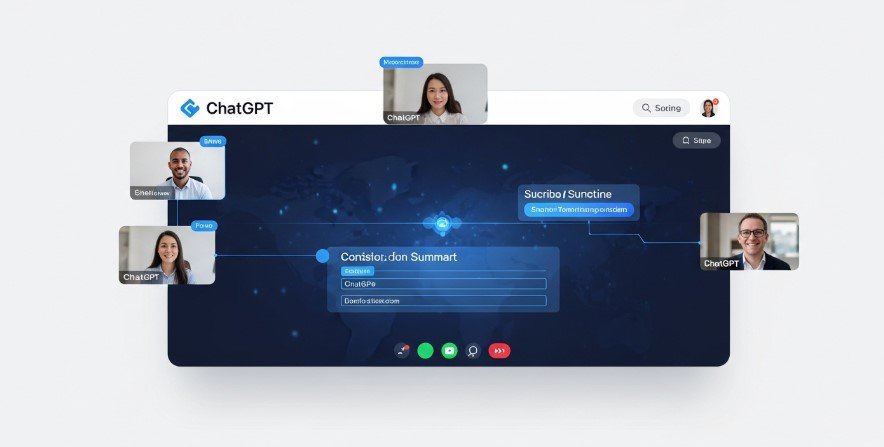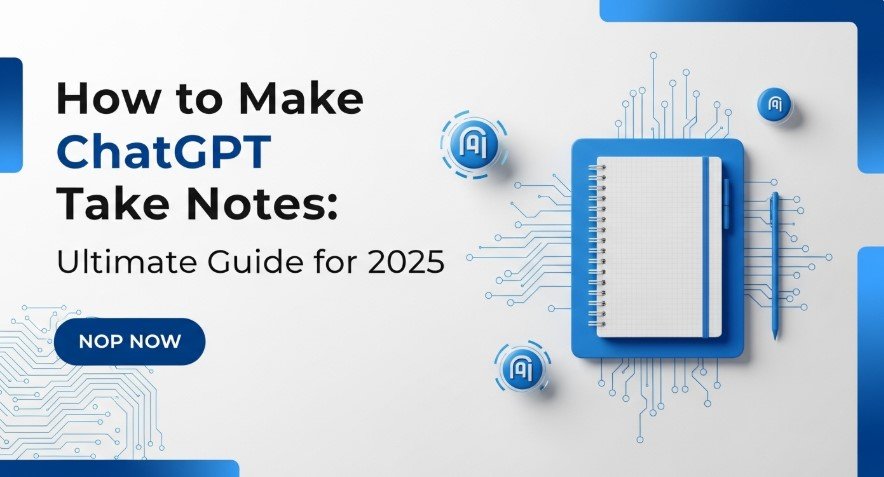In today’s fast-paced world, taking notes efficiently is key to staying organized and productive. ChatGPT, developed by OpenAI, is a powerful AI tool that can transform how you capture and manage information. Whether you’re summarizing meetings, creating study notes, or organizing ideas, this guide will show you how to use ChatGPT for note-taking in 2025. We’ll cover methods, best practices, tools, and real-world use cases to help you get the most out of this technology.
ChatGPT is an advanced AI language model that understands and generates human-like text. Its ability to process large amounts of information makes it ideal for note-taking. From transcribing meetings to summarizing lectures, ChatGPT can save time and improve accuracy. This guide, based on the latest updates as of July 2025, will walk you through practical ways to use ChatGPT for notes, ensuring you stay organized and efficient.

Methods to Use ChatGPT for Note-Taking
1. Direct Prompting
The simplest way to use ChatGPT for note-taking is by crafting specific prompts. A prompt is a clear instruction that tells ChatGPT what kind of notes you need.
- How to Do It:
- Identify the topic or content, like a meeting transcript or lecture.
- Write a precise prompt, e.g., “Summarize the key points from this meeting transcript in bullet points.”
- Input the prompt and any relevant text into ChatGPT’s interface.
- Example Prompt:
- “Act as a professor and provide detailed notes on artificial intelligence, including key terms and examples.”
- ChatGPT will generate structured notes based on the prompt.
- Tips:
- Specify the format (e.g., bullet points, headings).
- Include context, like “I’m a student studying for an exam,” to tailor the response.
2. Real-Time Note-Taking
As of June 5, 2025, ChatGPT offers a real-time note-taking feature for macOS users, announced during an OpenAI technical livestream. This feature transcribes spoken content, such as meetings or lectures, and generates summaries instantly.
- How to Use:
- Open the ChatGPT desktop app on macOS.
- Click the round icon on the right side of the chat window to start recording.
- ChatGPT transcribes the audio and extracts key points in real-time.
- For Non-macOS Users:
- Tools like VOMO AI or Tactiq integrate with ChatGPT to provide similar transcription and summarization for other platforms.
- Benefits:
- Saves time during live events.
- Captures key points without manual note-taking.

3. Integrating with Note-Taking Apps
ChatGPT can work with popular note-taking apps to streamline your workflow.
- How to Integrate:
- Use plugins or APIs to connect ChatGPT with apps like Google Docs, Notion, or Evernote.
- For example, set up ChatGPT to save notes directly to Google Drive or Notion.
- Benefits:
- Organizes notes in your preferred platform.
- Allows for easy editing and sharing.
- Example Tools:
- Google Docs: Paste ChatGPT-generated notes for collaboration.
- Notion: Use templates to structure AI-generated notes.
Best Practices for Using ChatGPT for Notes
1. Be Specific with Prompts
Clear prompts lead to better results. Vague prompts like “Take notes on this” may produce generic outputs. Instead, use detailed instructions.
- Good Prompt Example:
- “Summarize the main ideas and list key terms from this article on machine learning in bullet points.”
- Bad Prompt Example:
- “Take notes on machine learning.”
- Tip: Assign a role, like “Act as a professional minute-taker,” to focus the output.
2. Review and Refine
AI-generated notes may need human oversight to ensure accuracy, especially for nuanced or technical content.
- Steps:
- Check for missing details or errors.
- Refine prompts if needed, e.g., “Expand on the section about neural networks in the notes.”
- Why It Matters: Human review ensures notes capture the right tone and details.
3. Use Structured Formats
Structured notes are easier to read and use. Ask ChatGPT to organize notes with headings, bullet points, or numbered lists.
- Example Prompt:
- “Provide notes on cloud computing using H2 for main headings and H3 for subheadings, with bullet points for key details.”
- Result: Notes with clear sections, like “Overview,” “Key Features,” and “Examples.”
Use Cases
1. Meeting Notes
ChatGPT excels at summarizing meeting transcripts or recordings, making it ideal for professionals.
- How to Use:
- Obtain a transcript using tools like Tactiq or VOMO AI.
- Input the transcript with a prompt like: “Summarize key decisions, action items, and challenges from this meeting.”
- Example Output:
- Key Decisions: Approved project timeline.
- Action Items: John to finalize budget by Friday.
- Challenges: Limited resources for Q3.
2. Lecture Notes
Students can use ChatGPT to create study notes from lectures or textbooks.
- How to Use:
- Provide a lecture transcript or key points.
- Use a prompt like: “Extract main concepts from this lecture on biology and format as study notes.”
- Benefit: Creates concise notes for exam preparation.
3. Content Creation
ChatGPT can organize ideas into notes for blogs, articles, or presentations.
- How to Use:
- Input raw ideas or bullet points.
- Prompt: “Turn these points into a structured article outline.”
- Example: Converts scattered ideas into a clear outline with sections and subpoints.
4. Personal Knowledge Management
Use ChatGPT to organize personal research or ideas for long-term reference.
- How to Use:
- Input notes or thoughts.
- Prompt: “Categorize and summarize these ideas into a knowledge base.”
- Benefit: Builds a searchable library of insights.
Tools and Plugins
1. VOMO AI
VOMO AI enhances ChatGPT’s note-taking capabilities with advanced transcription and analysis.
- Features:
- Records and transcribes audio/video.
- Uses ChatGPT-4O to generate summaries and extract key points.
- How to Use:
- Upload files to VOMO AI.
- Refine outputs with ChatGPT prompts.
- Learn More: VOMO AI
2. Tactiq
Tactiq integrates with ChatGPT for real-time meeting transcription and summarization.
- Features:
- Transcribes meetings on platforms like Zoom or Google Meet.
- Offers AI-driven summaries without manual prompts.
- How to Use:
- Install Tactiq on your browser.
- Use during meetings to generate notes.
- Learn More: Tactiq
3. ChatGPT Plugins
Plugins like Note-Taker specialize in note-taking from various sources.
- Features:
- Creates notes from YouTube videos, articles, or transcripts.
- Delivers structured, concise outputs.
- How to Use: Access via ChatGPT’s plugin store and input your content.
Pros and Cons of Using ChatGPT for Note-Taking
| Aspect | Pros | Cons |
|---|---|---|
| Efficiency | Automates note-taking, saving time. | Requires specific prompts for best results. |
| Accuracy | Provides consistent summaries. | May miss nuances in complex discussions. |
| Availability | Accessible 24/7 for all users. | Primarily works in English. |
| Versatility | Handles meetings, lectures, and more. | Limited by input text length for long transcripts. |
Latest Updates (July 2025)
- Real-Time Feature: Launched on June 5, 2025, for macOS users, allowing live transcription and summarization.
- Model Improvements: The o3-pro model, introduced in 2025, enhances ChatGPT’s ability to process complex inputs, improving note quality.
- Tool Integrations: New tools like NoteGPT and VOMO AI offer specialized note-taking features, complementing ChatGPT.
Conclusion
ChatGPT is a powerful tool for note-taking, offering versatile methods to capture and organize information. Whether you’re using direct prompts, real-time transcription, or integrating with tools like VOMO AI or Tactiq, you can create high-quality notes with ease. By following best practices like crafting specific prompts and reviewing outputs, you can ensure your notes are accurate and useful. Try these techniques today to boost your productivity and stay organized.
Frequently Asked Questions (FAQ)
Can ChatGPT take notes automatically?
Yes, with the real-time feature for macOS users or tools like VOMO AI and Tactiq for other platforms.
Can ChatGPT transcribe audio files?
Yes, upload MP3 files and use prompts like: “Transcribe this audio and summarize key points.”
What are the best prompts for meeting notes?
Try: “Act as a professional minute-taker. Capture key decisions, action items, and challenges from this transcript.”
Can ChatGPT take notes from videos or textbooks?
Yes, provide transcripts or text and use prompts to generate structured notes.
